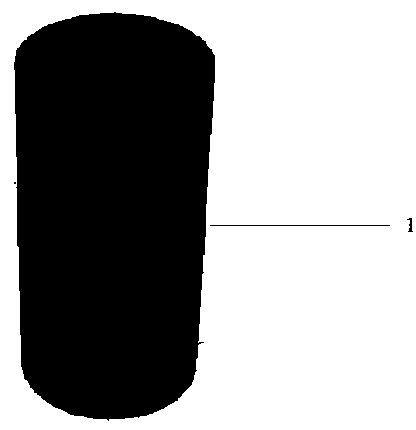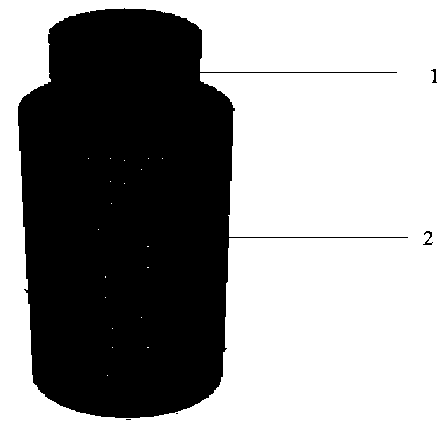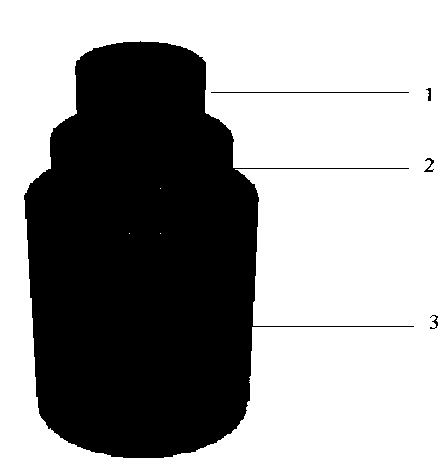Method for preparing coaxially-composite nano material by using carbon nano tube as core
A technology of composite nanomaterials and carbon nanotubes, applied in the fields of nanotechnology, nanotechnology, nanotechnology for materials and surface science, etc., can solve the problems of poor electrical conductivity and poor cycle performance, and achieve improved electrical conductivity and convenient operation. , the effect of improving structural stability
- Summary
- Abstract
- Description
- Claims
- Application Information
AI Technical Summary
Problems solved by technology
Method used
Image
Examples
Embodiment 1
[0026] Step 1) Disperse 0.5g of carbon nanotubes into a mixed solution of hydrochloric acid and sulfuric acid with a volume ratio of 1:3, treat it in an oil bath at 100°C for 1 hour, then filter it with suction, wash it with ethanol and deionized water in sequence, and transfer it to Dry in a drying oven at 50°C for 2 hours to obtain pure carbon nanotubes; figure 1 Schematic diagram of the structure of carbon nanotubes (CNTs);
[0027] Step 2) Weigh 0.3g of acidified carbon nanotubes and 0.6g of manganese acetate and disperse them into 20ml and 80ml of absolute ethanol solution under ultrasonic conditions, ultrasonically treat for 1h, and then add manganese acetate organic solution drop by drop into carbon nanotubes. In the tube organic solution, promptly obtain manganese acetate / carbon nanotube organic mixed solution;
[0028] Step 3): Stir the above manganese acetate / carbon nanotube organic mixed solution vigorously for 3 hours, perform suction filtration, wash with ethanol...
Embodiment 2
[0031] Step 1) Disperse 0.5g of carbon nanotubes into a mixed solution of hydrochloric acid and nitric acid with a volume ratio of 1:3, treat it in an oil bath at 110°C for 1.5h, then filter it with suction, wash with ethanol and deionized water in sequence, and transfer Dry in a drying oven at 60°C for 2 hours to obtain pure carbon nanotubes; figure 1 Schematic diagram of the structure of carbon nanotubes (CNTs);
[0032] Step 2) Weigh 0.3g of acidified carbon nanotubes and 1.2g of manganese acetate and disperse them into 20ml and 100ml of absolute ethanol solution respectively under ultrasonic conditions, ultrasonically treat for 2 hours, and then drop the manganese acetate organic solution into the carbon nanotubes drop by drop. In the tube organic solution, promptly obtain manganese acetate / carbon nanotube organic mixed solution;
[0033] Step 3): Stir the above-mentioned manganese acetate / carbon nanotube organic mixed solution vigorously for 6 hours, perform suction filt...
Embodiment 3
[0036] Step 1) Disperse 0.5g of carbon nanotubes into a mixed solution of sulfuric acid and hydrochloric acid with a volume ratio of 3:1, treat it in an oil bath at 120°C for 2 hours, then filter it with suction, wash it with ethanol and deionized water in sequence, and transfer it to Dry in a drying oven at 50°C for 4 hours to obtain pure carbon nanotubes; figure 1 is a schematic diagram of the structure of carbon nanotubes (CNTs), in which 1 is a carbon nanotube;
[0037] Step 2) Weigh 0.3g of acidified carbon nanotubes and 1.8g of manganese acetate and disperse them into 20ml and 90ml of absolute ethanol solution under ultrasonic conditions, ultrasonically treat for 2h, and then add manganese acetate organic solution dropwise into carbon nanotubes In the organic solution, obtain manganese acetate / carbon nanotube organic mixed solution;
[0038] Step 3): Stir the above-mentioned manganese acetate / carbon nanotube organic mixed solution vigorously for 9 hours, perform suction...
PUM
 Login to View More
Login to View More Abstract
Description
Claims
Application Information
 Login to View More
Login to View More - R&D
- Intellectual Property
- Life Sciences
- Materials
- Tech Scout
- Unparalleled Data Quality
- Higher Quality Content
- 60% Fewer Hallucinations
Browse by: Latest US Patents, China's latest patents, Technical Efficacy Thesaurus, Application Domain, Technology Topic, Popular Technical Reports.
© 2025 PatSnap. All rights reserved.Legal|Privacy policy|Modern Slavery Act Transparency Statement|Sitemap|About US| Contact US: help@patsnap.com



